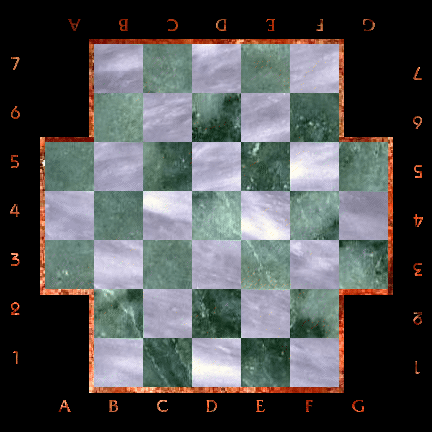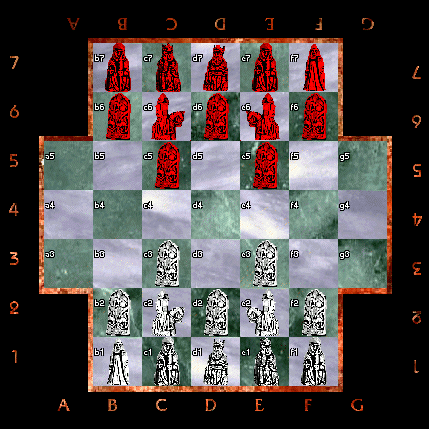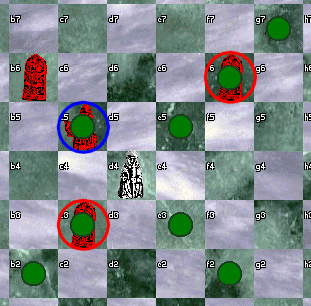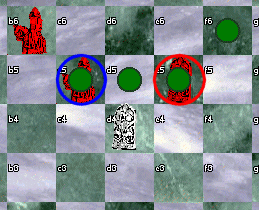Takeover Chess
Takeover Chess was designed for the Chess Variant Pages 41 Square Contest. It can be played on a standard 64-square board or a special 41-square board, described below. The game is played with the standard set of Chess pieces, except for one other, the "Mirror-Knight" (also seen in Double-Ended Chess). The standard FIDE Chess rules apply, except for the following: in addition to normal captures by replacement, pieces may jump over enemy pieces and capture them by "takeover"-- that is, they change owners. The specifics of this alternate type of capture are described below.
The idea of jump captures was borrowed from Jumping Chess, by Peter Aronson. The idea of taking over the piece captured was borrowed from Shogi, but modified by leaving the piece where it is instead of taking it off the board to drop later. The idea of allowing pieces to capture using one of two different methods (by replacement or by takeover) was inspired by Extreme Checkers, by Peter Aronson.
The description below is for the 41-square version of Takeover Chess. For those interested in the 64-square version, I would refer them to the Zillions of Games file, which can be downloaded here.
Board
The board is a 41-square board to comply with the contest rules. It is designed to maximize the playable area in the center, while still allowing for a reasonable array for the Chess pieces at their starting positions.
Setup for the 41 Square Version
- White

![]() Queen: e1
Queen: e1
![]() Rook: b1
Rook: b1
![]() Bishop: c1, f1
Bishop: c1, f1
![]() Knight: e2
Knight: e2
![]() Mirror-Knight: c2
Mirror-Knight: c2
- Red
![]() Knight: e6
Knight: e6
![]() Mirror-Knight: c6
Mirror-Knight: c6
![]() Pawn: b6, d6, f6, c5, e5
Pawn: b6, d6, f6, c5, e5
(Graphics credits: the board image was modified by Tony Quintanilla from the an original board image by Fergus Duniho, for the Zillions of Games implementation of Chessgi. The Chess pieces are by Tony Quintanilla and are after the Isle of Lewis Chess set.)
Rules
Takeover Chess is played like FIDE Chess with the following exceptions. During any turn any piece may make either a normal replacement capture or a "takeover" capture. A takeover is done by jumping over the enemy piece. Only one or the other type of capture may be done in a single turn, except for the Knights, which may do both. Any piece may be "taken over", except for the opponent's King.
The Knight is distinguished in that there are two types of Knights: the Knight proper and the Mirror-Knight. The difference being whether it first moves orthogonally or diagonally. The Knight is also distinguished in that it may make both a replacement capture and a jump takeover with the same move.
In the 41 Square variant, the other obvious differences are the board and the setup.
Pieces
The following illustrate the movement and captures in Takeover Chess. The green dots indicate squares where the piece can move. A red circles indicates enemy pieces that can be captured, either by replacement or takeover. A blue circle indicates pieces that may be captured only by replacement. A yellow circle indicates pieces that may be captured only by jump takeover. An arrow connects two pieces that may be captured in the same move by a Knight or Mirror-Knight.
 King: The King moves as in FIDE Chess.
It may capture by
replacement as in FIDE Chess, or,
alternatively, it may make a takeover capture. This is done by jumping over an
adjacent opposing piece along the same line, so long as there is an adjacent
empty square on the other side along the same line, the taken over piece is not
defended, and the King would not be in check upon
completing the jump.
King: The King moves as in FIDE Chess.
It may capture by
replacement as in FIDE Chess, or,
alternatively, it may make a takeover capture. This is done by jumping over an
adjacent opposing piece along the same line, so long as there is an adjacent
empty square on the other side along the same line, the taken over piece is not
defended, and the King would not be in check upon
completing the jump.
 Queen: The Queen moves as in FIDE
Chess, along orthogonals or the diagonals. It may capture
by replacement as in FIDE Chess, or,
alternatively, it may make a takeover capture. This is done by jumping over an
opposing piece along its line of movement, so long as there is no intervening
piece and there is an adjacent empty square on the other side along the same
line. Once the Queen has jumped over the opponent's piece, it may keep moving,
so long as there is no other piece in the way, and it has not reached the end of
the board.
Queen: The Queen moves as in FIDE
Chess, along orthogonals or the diagonals. It may capture
by replacement as in FIDE Chess, or,
alternatively, it may make a takeover capture. This is done by jumping over an
opposing piece along its line of movement, so long as there is no intervening
piece and there is an adjacent empty square on the other side along the same
line. Once the Queen has jumped over the opponent's piece, it may keep moving,
so long as there is no other piece in the way, and it has not reached the end of
the board.
Rook: The Rook moves as in FIDE Chess, along the
orthogonals. It may capture
by replacement as in FIDE Chess, or,
alternatively, it may make a takeover capture. This is done by jumping over an
opposing piece along its line of movement, so long as there is no intervening
piece and there is an adjacent empty square on the other side along the same
line. Once the Rook has jumped over the opponent's piece, it may keep moving,
so long as there is no other piece in the way, and it has not reached the end of
the board.
FIDE Chess, or,
alternatively, it may make a takeover capture. This is done by jumping over an
opposing piece along its line of movement, so long as there is no intervening
piece and there is an adjacent empty square on the other side along the same
line. Once the Rook has jumped over the opponent's piece, it may keep moving,
so long as there is no other piece in the way, and it has not reached the end of
the board.
 Bishop: The
Bishop moves as in FIDE Chess, along the diagonals. It may capture
by replacement as in FIDE Chess, or,
alternatively, it may make a takeover capture. This is done by jumping over an
opposing piece along its line of movement, so long as there is no intervening
piece and there is an adjacent empty square on the other side along the same
line. Once the Bishop has jumped over the opponent's piece, it may keep moving,
so long as there is no other piece in the way, and it has not reached the end of
the board.
Bishop: The
Bishop moves as in FIDE Chess, along the diagonals. It may capture
by replacement as in FIDE Chess, or,
alternatively, it may make a takeover capture. This is done by jumping over an
opposing piece along its line of movement, so long as there is no intervening
piece and there is an adjacent empty square on the other side along the same
line. Once the Bishop has jumped over the opponent's piece, it may keep moving,
so long as there is no other piece in the way, and it has not reached the end of
the board.
Knight: The Knight moves as in FIDE Chess, except that it
must first move one square
orthogonally and second one square diagonally. The Knight must stay inside the
board during the move. It may capture
by replacement as in FIDE Chess, or,
alternatively, it may make a takeover capture. This is done by jumping over an
opposing piece in the first square, so long as the second square is not occupied
by a friendly piece. If the second square is occupied by an opposing piece, that
piece is also captured by replacement. Thus, the Knight, along with the
Mirror-Knight, is unique in that it can
capture two pieces in the same move. Note that both the first and the second
square must be on the board for a move to be possible.
first move one square
orthogonally and second one square diagonally. The Knight must stay inside the
board during the move. It may capture
by replacement as in FIDE Chess, or,
alternatively, it may make a takeover capture. This is done by jumping over an
opposing piece in the first square, so long as the second square is not occupied
by a friendly piece. If the second square is occupied by an opposing piece, that
piece is also captured by replacement. Thus, the Knight, along with the
Mirror-Knight, is unique in that it can
capture two pieces in the same move. Note that both the first and the second
square must be on the board for a move to be possible.
 Mirror-Knight:
The Mirror-Knight moves as in FIDE Chess, except that it must first move one
square diagonally and second one square orthogonally. the Mirror-Knight must
stay inside the board during the move. It may capture
by replacement as in FIDE Chess, or,
alternatively, it may make a takeover capture. This is done by jumping over an
opposing piece in the first square, so long as the second square is not occupied
by a friendly piece. If the second square is occupied by an opposing piece, that
piece is also captured by replacement. Thus, the Mirror-Knight, along with the Knight, is unique in that it can
capture two pieces in the same move. Note that both the first and the second
square must be on the board for a move to be possible.
Mirror-Knight:
The Mirror-Knight moves as in FIDE Chess, except that it must first move one
square diagonally and second one square orthogonally. the Mirror-Knight must
stay inside the board during the move. It may capture
by replacement as in FIDE Chess, or,
alternatively, it may make a takeover capture. This is done by jumping over an
opposing piece in the first square, so long as the second square is not occupied
by a friendly piece. If the second square is occupied by an opposing piece, that
piece is also captured by replacement. Thus, the Mirror-Knight, along with the Knight, is unique in that it can
capture two pieces in the same move. Note that both the first and the second
square must be on the board for a move to be possible.
 Pawn: The
Pawn moves as in FIDE Chess. It may capture by
replacement as in FIDE Chess, or,
alternatively, it may make a takeover capture. This is done by jumping over an
adjacent opposing piece along a forward diagonal, so long as there is an adjacent
empty square on the other side along the same diagonal. The special
en-passant capture is permitted.
Pawn: The
Pawn moves as in FIDE Chess. It may capture by
replacement as in FIDE Chess, or,
alternatively, it may make a takeover capture. This is done by jumping over an
adjacent opposing piece along a forward diagonal, so long as there is an adjacent
empty square on the other side along the same diagonal. The special
en-passant capture is permitted.
Equipment
One way to play this game is to use Zillions of Games, described below. However, alternatively, one can print out this page and use a cut-out board and pieces. I have included separate images of the board and pieces, in the above sections, for just this use.
For the 64-square version, a standard Chess set may be used.
Notation:
Notation follows standard FIDE Chess notation, except that when a takeover capture is made, notate the move of the piece as a move and add a comment with the new color of the piece on the square taken over. For example, in the Pawn move illustration, above, the takeover of the Black Pawn on e5 would be notated as follows: Pawn d4 - f6 = White on e5.
Zillions of Games
You may play Takeover Chess on your computer with Zillions of Games.
Zillions of Games is a program that allows play of used defined games. It is ideal for Chess-variant play, since its artificial intelligence engine was designed first-of-all for Chess!
You may download the archived ZRF file and required image files here: TakeoverChess.zipThis ZRF file also contains a number of sub-variants in both 41 and 64 squares, one limiting takeover captures to pieces that are not defended, another limiting jumps to the square adjacent to the taken over piece, and a third allowing players to set up freely on their half of the board.
Enjoy!
Written by Tony Quintanilla. (Html slightly edited by Hans Bodlaender.)
WWW Page Created: Monday March 26, 2001. Last modified April 20, 2001.
